Storming the impregnable sea fortress of Corfu
Alexander Suvorov
215 years ago, 3 March 1799, the Russian-Turkish fleet under the command of Admiral Fedor Fedorovich Ushakov completed the operation to capture Corfu. French troops were forced to surrender the largest and most fortified of the Ionian Islands - Corfu. The capture of Corfu completed the liberation of the Ionian Islands and led to the creation of the Republic of the Seven Island, which was under the protectorate of Russia and Turkey and became the base for the Russian Mediterranean squadron.
prehistory
The French Revolution led to serious military-political changes in Europe. At first, revolutionary France defended itself, repelling the attacks of its neighbors, but soon it launched an offensive (“export of the revolution”). In 1796-1797 The French army, under the leadership of a young and talented French general, Napoleon Bonaparte, seized Northern Italy (The first serious victory of Napoleon Bonaparte. Brilliant Italian campaign 1796-1797.). In May 1797, the French captured the Ionian Islands belonging to the Republic of Venice (Corfu, Zante, Kefalonia, St. Moors, Cerigo and others), which were located along the western coast of Greece. The Ionian Islands were of great strategic importance, control over them allowed to dominate the Adriatic Sea and the Eastern Mediterranean.
France had extensive conquest plans in the Mediterranean. In 1798, Napoleon launched a new aggressive campaign - the French Expeditionary Army headed for the capture of Egypt (Battle of the pyramids. Egyptian campaign of Bonaparte). From there, Napoleon planned to repeat the campaign of Alexander the Great, his minimum program included Palestine and Syria, and with the successful development of hostilities, the French could move to Constantinople, Persia and India. Napoleon successfully avoided a collision with the British fleet and landed in Egypt.
On the way to Egypt, Napoleon captured Malta, which, in fact, then belonged to Russia. The capture of Malta by the French was perceived by Pavel Petrovich as an open challenge to Russia. The Russian sovereign Paul I was the Grand Master of the Order of Malta. Soon followed another reason for Russia's intervention in Mediterranean affairs. After the landing of the French troops in Egypt, which was formally part of the Ottoman Empire, Porta asked Russia for help. Pavel decided to oppose France, which in Russia was considered a hotbed of revolutionary ideas. Russia became part of the Second Anti-French Coalition, of which Britain and Turkey also became active participants. December 18 Russia 1798 concludes preliminary agreements with the British on the restoration of the union. 23 December 1798 Russia and Port signed an agreement by which ports and Turkish straits were opened for Russian ships.
Even before the conclusion of a formal agreement with the alliance between Russia and Turkey, it was decided to send ships of the Black Sea Fleet to the Mediterranean. When the campaign plan for the Mediterranean appeared in Petersburg, the squadron under the command of Vice-Admiral Ushakov was in a long campaign. For four months the ships of the Black Sea Fleet plowed the waters of the Black Sea, only occasionally visiting the main base. In early August, 1798, the squadron planned to make another visit to the base. 4 August squadron approached Sevastopol "to pour fresh water". A courier from the capital climbed onto the flagship and gave Ushakov an order from Emperor Paul I: immediately go to the Dardanelles and, at Porta’s request for help, render assistance to the Turkish fleet in the fight against the French. Already 12 August squadron went on the march. It consisted of 6 battleships, 7 frigates and ship's 3 messengers. Amphibious forces made up the 1700 naval grenadier of the Black Sea Navy battalions and the 35 midshipman of the Nikolaev Navy School.
The campaign had to begin in the conditions of sea excitement. Some ships were damaged. On two ships it was necessary to carry out serious repairs and they were sent back to Sevastopol. When the squadron of Ushakov arrived in the Bosphorus, representatives of the Turkish government immediately arrived at the admiral. Together with the British ambassador, negotiations began on a plan of action for the allied fleets in the Mediterranean. As a result of the negotiations, it was decided that the squadron of Ushakov would head for the western coast of the Ionian Islands and its main task would be to free the Ionian Islands from the French. In addition, Russia and Turkey were supposed to support the British fleet in the blockade of Alexandria.
For joint operations with the Russian squadron, the Ottoman fleet was assigned a squadron of Turkish ships under the command of Vice Admiral Kadyr-Bey, who came under the command of Ushakov. Kadyr Bey was supposed to "honor our Vice Admiral Yako teacher." The Turkish squadron included 4 battleships, 6 frigates, 4 corvette and 14 gunboats. Istanbul has undertaken to provide the Russian ships with everything they need.
From the combined Russian-Turkish fleet, Ushakov singled out the 4 frigate and 10 gunboats, which, under the command of the captain of the 1 rank A. A. Sorokin, headed for Alexandria for the blockade of the French. Thus, Russia and Turkey supported the allies. Many ships of the British squadron Nelson were damaged in the battle of Abuquir and went to repair in Sicily.
September 20 squadron Ushakova left the Dardanelles and moved to the Ionian Islands. The liberation of the islands began with Cerigo. In the evening of September 30, Admiral Ushakov offered the French to fold weapon. The enemy promised to fight "to the last extreme." In the morning of October 1, an artillery bombardment of the fortress of Kapsali began. Initially, the French artillery was actively responding, but when the Russian troops prepared for the assault, the French command ceased resistance.
Two weeks later, the Russian fleet approached the island of Zante. Two frigates approached the coast and crushed the enemy’s seaside batteries. Then the landing was landed. Together with the locals, Russian sailors surrounded the fortress. The French commandant, Colonel Lucas, seeing the hopelessness of the situation, capitulated. About 500 French officers and soldiers surrendered. Russian sailors had to defend the French from the fair vengeance of the locals. It must be said that during the liberation of the Ionian Islands, the locals very happily greeted the Russians and actively helped them. The French behaved like savages, robbery and violence were commonplace. The help of the local population, which knew well the waters, the terrain, all the paths and approaches, was very helpful.
After the liberation of the island of Zante, Ushakov divided the squadron into three detachments. Four ships under the command of Captain 2 rank D. N. Senyavin went to the island of St. The Moors, six ships under the command of Captain 1 of rank I. A. Selivachev went to Corfu, and five ships of Captain 1 of rank I. S. Poskochina went to Kefalonia.
In Kefalonia, the French surrendered without a fight. The French garrison fled to the mountains, where he was captured by the locals. On the island of sv. The French Moors refused to surrender. Senyavin landed the assault force with artillery. After the 10-day bombing and the arrival of the squadron of Ushakov, the French commander Colonel Miolet went to negotiate. 5 November the French laid down their arms.
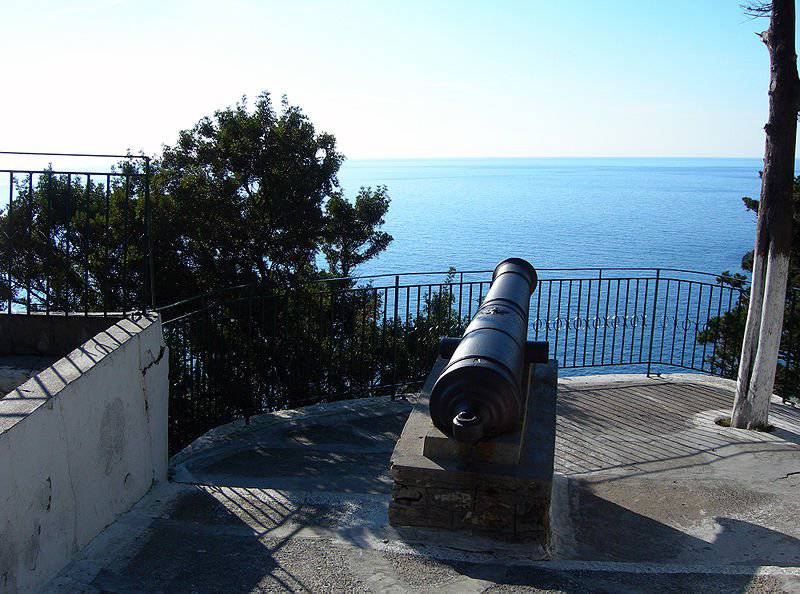
Russian cannon of the times of the joint Russian-Turkish campaign in Corfu.
Fortifications of the island and the strength of the parties
After the liberation of the island of sv. Marfa Ushakov went to Corfu. The first to the island of Corfu arrived the detachment of Captain Selivachev: 3 battleship, 3 frigate and a number of small ships. The squad arrived on the island 24 October 1798 of the year. October 31 to the island arrived detachment of the captain of the 2-th rank Poskochin. On November 9, the main forces of the combined Russian-Turkish fleet under Ushakov approached Corfu. As a result, the combined Russian-Turkish forces had 10 battleships, 9 frigates and other ships. In December, the squadron was joined by detachments of ships under the command of Rear Admiral P. V. Pustoshkin (74-gun battleship St. Michael and Simeon and Anna), Captain 2 rank A. A. Sorokin (frigates St. Michael and "Kazan Mother of God"). Thus, the Allied squadron had 12 battleships, 11 frigates and a significant number of small ships.
Corfu was located on the east coast in the central part of the island and consisted of a whole complex of powerful fortifications. Since ancient times, the city was considered the key to the Adriatic Sea and was well fortified. French engineers supplemented the old fortifications with the latest achievements of fortification science.
In the eastern part, on a steep cliff, the “Old Fortress” (sea, Venetian or Paleo Frurio) was located. From the main city, the Old Fortress was separated by an artificial moat. Behind the moat was located the “New Fortress” (coastal or Neo Frurio). The city from the side of the sea was protected by a steep bank. In addition, he was surrounded on all sides by a high double shaft and moat. Throughout the shaft were moats. Also, from the land side, the city was defended by three forts: San Salvador, San Roque and Abraham-Frot. The most powerful was San Salvador, which consisted of casemates cut into the rocks, connected by underground passages. From the sea, the city was covered by the well-protected island of Vido. It was the high mountain that dominates Corfu. On the approaches to Vido from the sea, booms with iron chains were installed.
The governor of the islands, divisional general Shabot and General Commissar Dubois, commanded the defense of the city. Brigadier General Pivron commanded Vido garrison. Before arriving at the island of the Russian squadron, Dubois transferred a significant part of the troops from other islands to Corfu. At Corfu, the French had 3 thousand soldiers, 650 guns. Vido defended 500 soldiers and 5 artillery batteries. In addition, the space between the islands of Corfu and Vido served as a parking for French ships. It housed a squadron of 9 pennants: 2 battleships (74-cannon "Zhenerosa" and 54-cannon "Leander"), 1 frigate (32-gun Frigate "La Brune"), bombarding ships "La Friemar" brig "expeditionary And four auxiliary vessels. The French squadron had up to 200 guns. From Ancona they planned to transfer more 3 thousand soldiers with the help of several military and transport ships, but after learning about the situation in Corfu, the ships returned.
New Fortress.
Siege and storming of Corfu
Upon arrival at Corfu, the ships of Selivachev began the blockade of the fortress. Three ships took positions at the Northern Strait, the rest - at the South. The French offered to capitulate, but the offer of surrender was rejected. October 27 French conducted reconnaissance in force. The ship Zhenerés got close to the Russian ship Zachary and Elizabeth and opened fire. The Russians answered, the French did not dare to continue the battle and turned back. In addition, the Russian ships captured the French 18-gun brig and three vehicles that tried to break through to the fortress.
After the arrival of the squadron of Ushakov, several ships approached the port of Gouvy, located in 6 km north of Corfu. Here was located the village with the old shipyard. But almost all the buildings were destroyed by the French. In this harbor, Russian sailors organized coastal bases. In order to suppress the French garrison’s ability to replenish provisions by plundering local residents, Russian sailors, with the help of the local population, began to build batteries and earthworks in the area of the fortress. On the north bank, a battery was installed on the Mount Oliveto Hill (Mount Olivet). Here was located the detachment of captain Kikin. From the hill it was convenient to bombard the forward forts of an enemy fortress. 15 November battery opened fire on the fortress. South of the fortress also installed a battery. Here was a detachment of Ratmanov. They gradually formed militia of about 1,6 thousand people from local residents.
The French command was counting on impregnable fortifications of the fortress, and it was certain that the Russian sailors could not take it by storm and would not be able to carry out a long siege, they would leave Corfu. General Shabo tried to wear down the besiegers, keeping them energized, conducting attacks and artillery shelling every day, which required constant vigilance from the Russian sailors and readiness to repel the attacks of the French. In many ways, these were correct calculations. The besiegers experienced tremendous difficulties with ground forces, artillery and supplies. However, the Russian squadron was led by Iron Ushakov, and the French fortress was besieged by the Russians, not the Turks, so the calculation was not justified.
The entire burden of the siege of Corfu was carried on their shoulders by Russian sailors. The assistance of the Turkish squadron was limited. Kadir Bey did not want to risk his ships and tried to refrain from direct clashes with the enemy. Ushakov wrote: "I am on their shore, like a red egg, and in danger ... I do not let in, and they themselves are not hunters to that." In addition, the Ottomans did not carry out their combat missions. So, on the night of January 26, the battleship Zeneros, following Napoleon’s order, broke through from Corfu. The French painted the sails black to disguise. The Russian patrol vessel found the enemy and gave a signal about it. Ushakov ordered Kadyr Bey to chase the enemy, but he ignored this instruction. Then Lieutenant Metax was sent to the Ottoman flagship to force the Ottomans to carry out the order of the admiral. But the Turks did not leave the anchor. Generos, along with the brig, quietly left for Ancona.
The blockade of the fortress weakened its garrison, but it was obvious that Corfu needed an assault. And for the assault there were no necessary forces and means. As Ushakov noted, the fleet was far from supply bases and was in great need. Russian sailors were literally deprived of all that was required for conventional combat operations, not to mention the storming of a first-class fortress. Contrary to the promises of the Ottoman command, Turkey did not allocate the necessary number of ground forces for the siege of Corfu. In the end, about 4,2 of thousands of soldiers were sent from Albania, although they promised 17 of thousands of men. The situation was also bad with siege land artillery and ammunition. The lack of ammunition hampered any combat activity. Ships and batteries were silent for a long time. Ushakov ordered to protect those who have shells, to shoot only when absolutely necessary.
The squadron was also in great need of food. The situation was close to disaster. For months, the sailors lived on food rations, neither from the Ottoman Empire, nor from Russia there was a supply of provisions. But the Russians could not take the example of the Ottomans and the French, rob the already destitute local population. Ushakov informed the Russian ambassador in Constantinople that they were interrupted by the last little crumbs, they were starving. Moreover, even the food supplied was of disgusting quality. So, in December 1798, the transport “Irina” with corned beef arrived from Sevastopol. However, much of the meat was rotten, with worms.
The sailors on the ships were stripped, in need of uniforms. At the very beginning of the campaign, Ushakov informed the Admiralty that the sailors had not received a salary, uniforms and uniform money for the year. Having uniforms fell into disrepair, there were no ways to remedy the situation. Many did not have shoes. When the squadron received the money, it turned out that there was no benefit from them - the officials sent paper banknotes. Nobody accepted such money, even with a significant reduction in their price. Therefore, they were sent back to Sevastopol.
The situation was aggravated by the fact that Petersburg was trying to lead the squadron. Orders came, the orders of Paul and senior dignitaries who were already outdated, did not respond to the military-political situation or the situation in the Mediterranean theater of operations. So, instead of concentrating all the forces of the squadron at Corfu. Ushakov now and then had to send ships to other places (to Ragusa, Brindisi, Messina, etc.). This hampered the effective use of Russian forces. In addition, the British, who themselves wanted to liberate and capture the Ionian Islands for themselves, sought to weaken the Russian squadron, insisting that Ushakov allocate ships to Alexandria, Crete and Messina. Ushakov, rightly appreciated the vile maneuver of the “ally” and told the ambassador to Constantinople that the British want to distract the Russian squadron from real work, “make them catch flies,” and take the “places from which they are trying to keep us away”.
In February 1799, the position of the Russian squadron improved somewhat. Ships arrived in Corfu and sent earlier to carry out various assignments. They brought several detachments of auxiliary Turkish troops. 23 January (3 February) 1799, on the southern side of the island began to build new batteries. Therefore, Ushakov decided to move from a siege to a decisive assault on the fortress. 14 (25) February began the final preparations for the assault. Sailors and soldiers were taught methods of overcoming various obstacles, the use of assault ladders. A large number of ladders were made.
First, Ushakov decided to take the island of Vido, which he called the “key to Corfu”. The ships of the squadron were supposed to suppress the enemy’s coastal batteries, and then land the assault forces. At the same time, the enemy should have been attacked by detachments located on the island of Corfu. They were supposed to hit the forts of Abraham, sv. Roca and Salvador. Most commanders fully endorsed the Ushakov plan. Only a few Ottoman commanders called the plan of operation "unrealizable." However, they were in the minority.
February 17 ships received orders - at the first comfortable wind, to attack the enemy. At night, February 18 wind was south-west, did not have to count on a decisive attack. But in the morning the weather changed. A fresh breeze blew from the northwest. On the flagship they raised a signal: “prepare the whole squadron for the attack on Vido island”. At 7, two shots rang out from the ship St. Paul. It was a signal to Corfu land forces to launch shelling of enemy fortifications. Then began to move to the position of the ships.
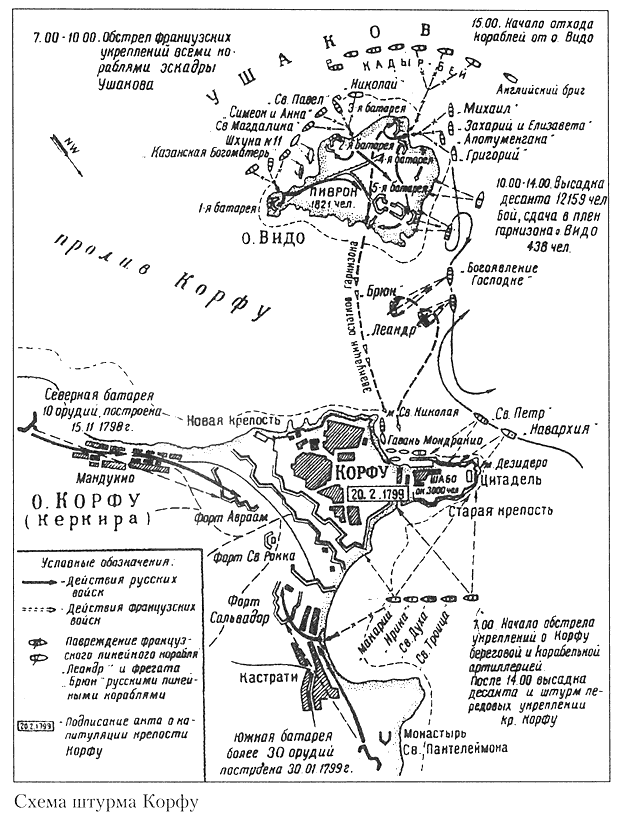
Corfu 18 February 1799 assault of the year.
In the forefront were three frigates, they attacked the first battery. Behind them followed the rest of the ships. "Pavel" fired at the first enemy battery, and then concentrated its fire on the second battery. The ship was located at such close range that it was possible to use all the tools. Other ships followed the flagships: the battleship Simeon and Anna commanded by Captain 1 of the rank of K.S. Leontovich, Magdalen by Captain of 1 of the rank of G.A. Timchenko; Closer to the northwestern cape of the island were the positions of the ship “Mikhail” under the command of I. Ya. Saltanov, the “Zachary and Elizabeth” of captain I. A. Selivachev, the frigate “Grigory” of captain-lieutenant I. A. Shostak. The ship "Epiphany" under the command of A.P. Aleksiano did not stand on the anchor, firing enemy batteries on the move. Kadyr-Bey ships were located at some distance, without risking to get close to the French batteries.
In order to paralyze the French ships, Ushakov singled out the ship “Peter” under the command of D. N. Senyavin and the frigate Navarhia under the command of N. D Voinovich. They fired with the French ships and the fifth battery. Assistance to them provided the ship "Epiphany", in the course of its movement shelling these targets. Under the influence of Russian fire, French ships were badly damaged. The battleship Leander was especially damaged. He barely kept afloat, he left his position and took refuge at the walls of the fortress. Russian ships drowned and several galleys with troops on them, which were designed to strengthen the Vido garrison.
Initially, the French fought bravely. They were sure that the batteries were impregnable against the attack from the sea. Stone parapets and earthen ramparts protected them well. However, as the battle continued, confusion grew in the ranks of the enemy. Russian ships volley after salvo hit the French batteries and were not going to retreat. The losses of the French grew, the gunners died, the guns were out of action. By 10 watches, French batteries have significantly reduced the intensity of the fire. The French gunners began to leave their positions and flee inland.
Ushakov, as soon as he noticed the first signs of weakening enemy fire, ordered to begin preparations for unloading the landing force. Amphibious groups on the boats and boats headed for the island. Under cover of the ship's artillery, the ships began to land the landing forces. The first group landed between the second and third batteries, where the ship's artillery struck the enemy the hardest hit. The second squad landed between the third and fourth batteries, and the third at the first battery. In total, about 2,1 of thousands of paratroopers were landed on the coast (of which about 1,5 thousand were Russian warriors).
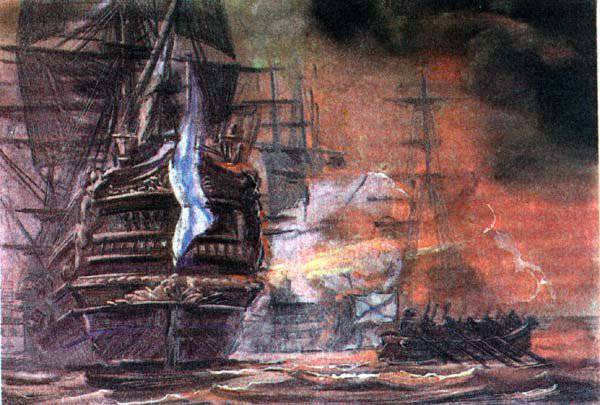
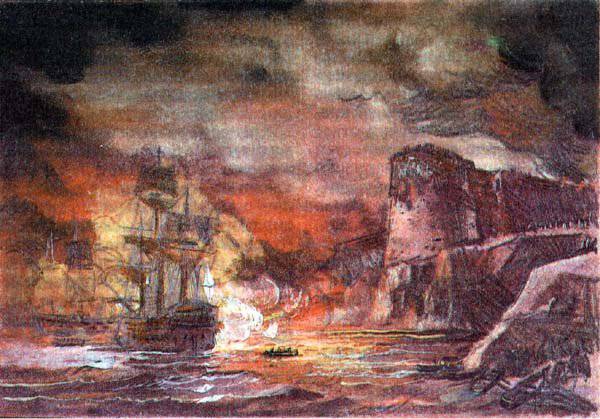
Storming the fortress of Corfu. V. Kochenkov.
General Pivron at the time of the assault created a serious antiamphibious defense of the island: they installed obstacles that prevented the movement of rowing ships, debris, earthen embankments, wolf holes, etc. Not only from land did they fire on landing ships. But also standing on the coast of small vessels. However, the Russian sailors overcame all obstacles. Having fixed themselves on the coast, the Russian paratroopers began to crowd the enemy, seizing one position after another. They moved to the batteries, which were the main nodes of resistance. First, the third battery was captured, then the Russian flag was raised above the strongest, second battery. The French ships stationed by Vido were captured. The French soldiers ran to the south side of the island, hoping to escape to Corfu. But the Russian ships blocked the path of the French rowing ships. Around noon, the first battery fell. The French could not stand the onslaught of Russian sailors and surrendered.
By 14 hours the battle was over. The remnants of the French garrison laid down their arms. The Turks and Albanians, embittered by the stubborn resistance of the French, began to cut the prisoners, but the Russians defended them. Of the 800 people who were defending the island, 200 people were killed, 402 soldiers, 20 officers and the commandant of the island, Brigadier General Peevron, were taken prisoner. About 150 people were able to escape to Corfu. Russian casualties were 31 people killed and 100 wounded, Turks and Albanians lost 180 people.
Capturing Vido predetermined the outcome of the assault on Corfu. On the island of Vido were put Russian batteries, which opened fire on Corfu. While the battle was on for Vido, the Russian batteries on Corfu were shelling the enemy’s fortifications in the morning. Several ships that did not participate in the storming of Vido were shelled by the fortress. Then the airborne troops began the assault on the French advanced fortifications. Locals showed paths that allowed to bypass the mined approaches. At the fort, Salvador began a hand-to-hand fight. But the French attacked the first attack. Then, reinforcements were landed from ships in Corfu. Storming the enemy positions resumed. The sailors acted heroically. Under enemy fire, we made our way to the walls, set the stairs, and climbed the fortifications. Despite the desperate resistance of the French, all three advanced forts were captured. The French fled to the main fortifications.
By the evening of February 18 (March 1) battle verse. The apparent ease with which the Russian sailors took Vido and the advanced forts demoralized the French command. The French, having lost about 1 thousand people in one day of battle, decided that resistance was meaningless. The next day, a French boat arrived at the ship of Ushakov. Adjutant French commander suggested truce. Ushakov offered to surrender the fortress in 24 hours. Soon the fortress was informed that they agreed to lay down their arms. February 20 (March 3) The 1799 of the surrender was signed.
Results
February 22 (March 5) The French garrison among the 2931 people, including the 4 generals, surrendered. Admiral Ushakov was given the French flags and the keys to Corfu. Troops of Russia were about 20 combat and auxiliary vessels, including the battleship Leander, the frigate Labrun, brig, bombing ship, three brigantines and other ships. On the fortifications and in the arsenal of the fortress 629 guns were captured, about 5 thousand guns, over 150 thousand kernels and bombs, more than half a million rounds of ammunition, a large number of different equipment and food.
According to the terms of the surrender, the French, having surrendered the fortress with all the tools, arsenals and shops, retained their freedom. They only vowed not to fight against Russia and its allies during the 18 months. The French were sent to Toulon. But this condition did not concern the hundreds of Jews who fought with the French. They were sent to Istanbul.
Allied forces lost 298 people killed and wounded, of which 130 are Russian and 168 are Turks and Albanians. Sovereign Paul made Ushakov admirals and rewarded with the diamond signs of the Order of St. Alexander Nevsky. The Ottoman Sultan sent a firman with praise and donated cheleng (a golden feather strewn with diamonds), a sable fur coat and 1000 gold coins for small expenses. Another 3500 ducats sent for the team.
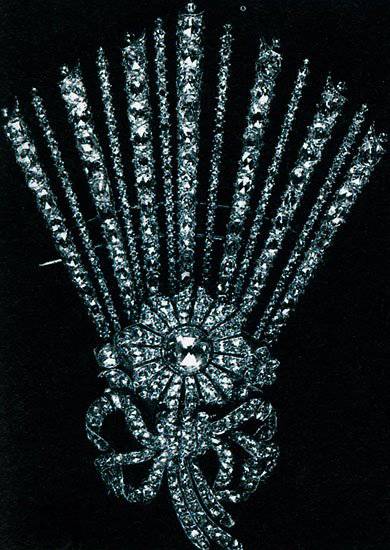
Cheleng (a gold feather studded with diamonds), presented by the Turkish Sultan FF Ushakov.
The victory at Corfu completed the liberation of the Ionian Islands from the power of the French and made a great impression on Europe. The Ionian Islands became the stronghold of Russia in the Mediterranean. European military and politicians did not expect such a decisive and victorious outcome of the struggle against the powerful stronghold of France in the Mediterranean. Many believed that Vido would be very difficult to take, and Corfu was impossible at all. The fortress had a sufficient garrison, supported by a detachment of ships, first-class fortifications, powerful artillery weapons, large stocks of ammunition and supplies, but could not withstand the onslaught of Russian sailors. “All friends and enemies have respect and reverence for us,” admiral Ushakov noted.
The brilliant skill of the Russian sailors was recognized by the enemies of Russia - the French military leaders. They said that they had never seen anything like it and had never heard of it; they did not imagine that it was possible with some ships to take the terrible batteries of Corfu and the island of Vido. Such courage was hardly ever seen.
The capture of Corfu clearly showed the creative nature of the skill of Admiral Ushakov. The Russian admiral showed a flawed opinion that the attack of a strong fortress from the sea is impossible. Shipboard artillery became the main means that ensured the suppression of enemy coastal forces. In addition, much attention was paid to the Marine Corps, the organization of landing operations to capture bridgeheads and the construction of coastal batteries. The victorious assault on Vido and Corfu overturned the theoretical constructions of Western European military specialists. Russian sailors have proven that they can perform the most complex combat missions. The assault of the red line, which was considered an impregnable sea fortress, is inscribed in history Russian school of naval art.
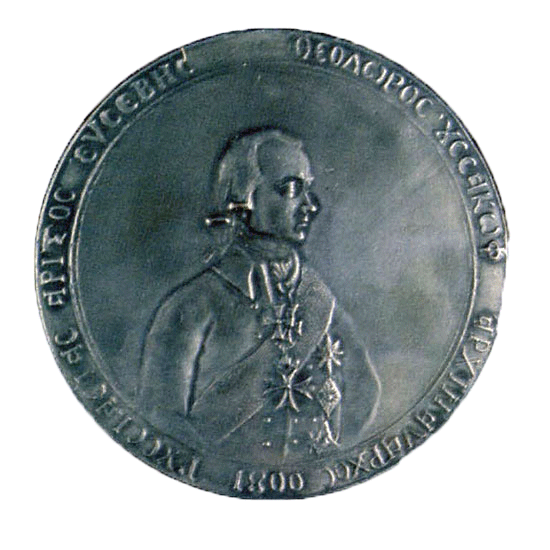
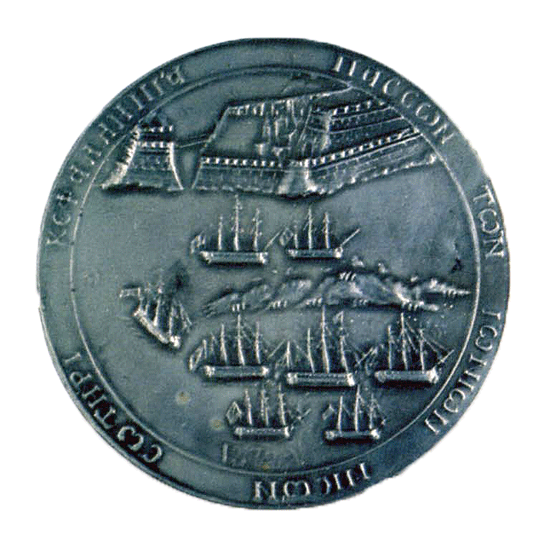
Medal minted in honor of F.F. Ushakov in Greece. Central Naval Museum.
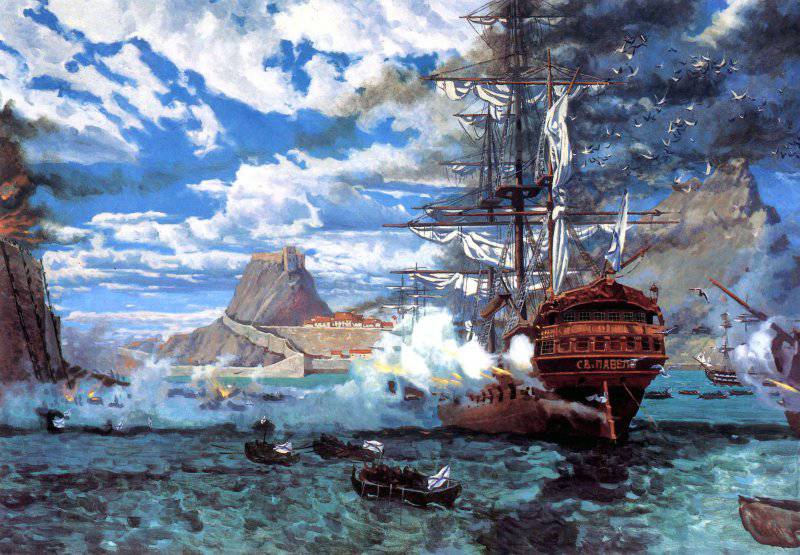
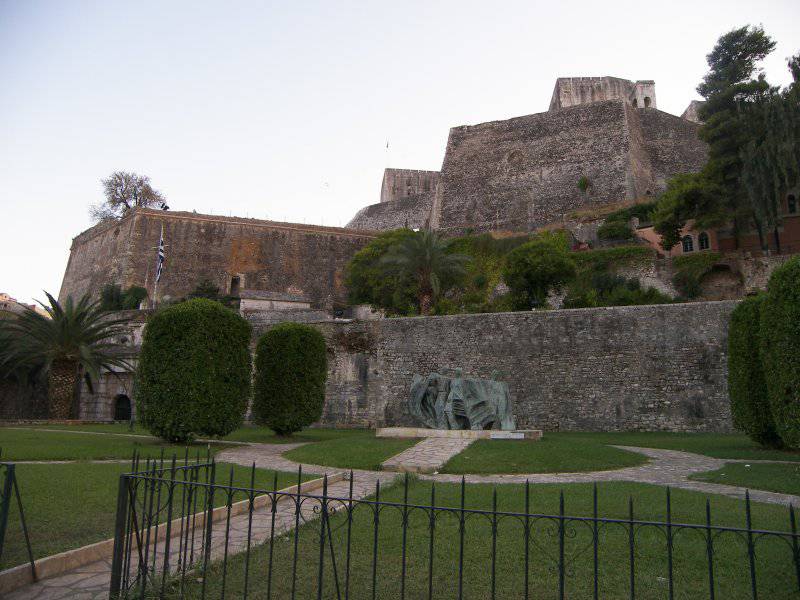
Information